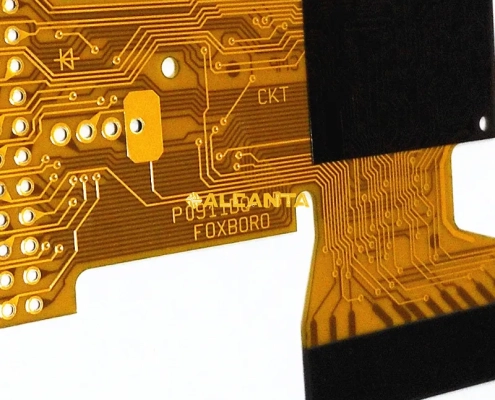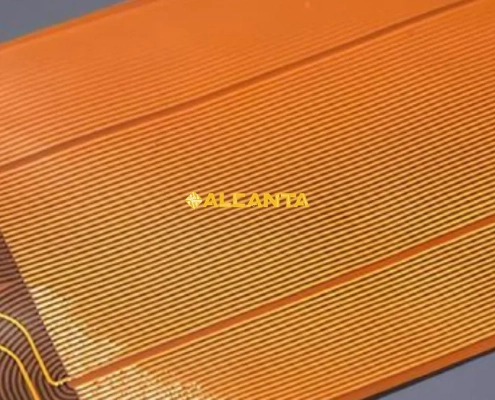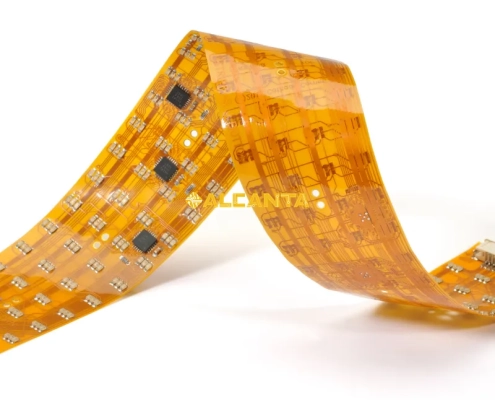Flexible PCB Mastery: Crafting Next-Gen Electronics with Flexibility
Printed Circuit Boards (PCBs) serve as the intricate foundation of electronic devices, evolving from basic single-sided configurations to sophisticated multi-layered structures, driving the miniaturization and efficiency of modern electronics. Among these advancements, Flexible PCBs stand out as a groundbreaking innovation, introducing a pliable design that seamlessly integrates flexibility with functionality. This transformative shift in PCB technology not only allows for intricate circuitry but also enables the development of versatile electronic devices such as wearable technology, foldable smartphones, and flexible medical sensors. The evolution of PCBs showcases a continual journey of adaptation and improvement, empowering electronics to push boundaries and redefine possibilities in the dynamic landscape of technological innovation.
Rigid PCB vs Flexible PCB: Navigating the Differences
Definition of Rigid PCB
- Characteristics: Rigid Printed Circuit Boards (PCBs) are inflexible, typically composed of solid substrates such as fiberglass or epoxy. These boards maintain a fixed form, providing stability and durability to electronic assemblies.
- Common Applications: Rigid PCBs find prevalence in applications where a stable and unyielding platform is paramount. Common uses include computers, laptops, servers, and consumer electronics, where a rigid structure ensures the integrity of the electronic components.
Definition of Flexible PCB
- Characteristics: Flexible PCBs, in contrast, feature a pliable structure due to the use of flexible substrate materials like polyimide. This flexibility allows the board to bend, twist, or fold, making it suitable for applications with dynamic form factors.
- Common Applications: Flexible PCBs are a cornerstone in the development of cutting-edge devices like wearable technology, flexible displays, and medical sensors. Their adaptability makes them ideal for products requiring intricate designs and the ability to conform to irregular shapes.
Key Differences between Rigid and Flexible PCBs
- Structure and Material: Rigid PCBs utilize solid materials like fiberglass or epoxy, offering stability but limiting flexibility. On the other hand, Flexible PCBs employ pliable substrates such as polyimide, enabling them to conform to different shapes and sizes.
- Design Flexibility: Rigid PCBs are confined to fixed shapes, limiting design options. In contrast, Flexible PCBs provide unparalleled design flexibility, allowing for innovative and space-efficient layouts that adapt to unique product designs.
- Application Suitability: While Rigid PCBs excel in applications demanding stability, Flexible PCBs shine in dynamic environments where flexibility and adaptability are crucial. Industries like wearable tech, automotive interiors, and medical devices leverage the unique benefits of Flexible PCBs for enhanced functionality and design freedom.
What is a Flexible PCB: Unveiling the Intricacies
Definition and Basic Structure
A Flexible Printed Circuit Board (Flexible PCB) is a specialized type of PCB designed with a pliable substrate, typically polyimide, that allows the board to bend or flex without compromising functionality. This unique design enables Flexible PCBs to adapt to unconventional shapes and contours, offering unparalleled flexibility in electronic design.
Types of Flexible PCBs
- Single-Sided Flexible PCBs: Single-sided Flexible PCBs consist of a single conductive layer on one side of the flexible substrate. These boards are suitable for simpler electronic applications where flexibility is essential but intricate circuitry is not a primary requirement.
- Double-Sided Flexible PCBs: Double-sided Flexible PCBs feature conductive layers on both sides of the flexible substrate, allowing for more complex circuit designs. This type is commonly employed in applications requiring a higher level of connectivity and functionality.
- Multilayer Flexible PCBs: Multilayer Flexible PCBs incorporate multiple layers of conductive material separated by insulating layers. This design enables the creation of highly intricate and dense circuits, making them ideal for advanced electronic devices with complex requirements.
Materials Used in Flexible PCBs
- Base Material: The base material of Flexible PCBs is crucial for providing the required flexibility. Polyimide, a high-performance polymer, is commonly used due to its excellent thermal stability, flexibility, and resistance to chemicals.
- Conductive Material: Conductive materials in Flexible PCBs typically include copper due to its excellent electrical conductivity. The conductive traces are patterned onto the flexible substrate using processes like etching, allowing for the creation of intricate circuit paths.
Understanding the intricate balance of materials and design choices in Flexible PCBs enables the development of electronic devices with enhanced adaptability and functionality.
Can PCB be Flexible? Navigating the Challenges and Innovations
Challenges in Making Flexible PCBs
- Material Selection: Achieving flexibility in PCBs poses challenges in material selection. The traditional rigid substrates like fiberglass are replaced with materials such as polyimide, but choosing the right blend of flexibility, durability, and thermal stability is critical. Striking this balance ensures that the Flexible PCB can bend without compromising its structural integrity or electrical performance.
- Manufacturing Processes: The manufacturing processes for Flexible PCBs differ significantly from their rigid counterparts. Precision is paramount, and techniques like laser drilling and chemical etching are employed to create intricate circuit patterns on flexible substrates. Ensuring consistency and reliability in these processes is crucial to meet the demands of flexible electronics.
Advancements in Technology Enabling Flexibility
- Rigid-Flex PCBs: Rigid-flex PCBs represent a significant advancement, combining the benefits of both rigid and flexible boards. These boards feature both rigid and flexible sections, allowing for versatile designs that can withstand bending and folding while maintaining structural stability. Rigid-flex PCBs are increasingly utilized in applications where a combination of flexibility and rigidity is essential.
- Flexible Materials Development: Continuous innovations in material science have led to the development of new flexible materials with enhanced properties. Flexible substrates, like polyimide films with improved flexibility and durability, are now available. These advancements empower designers to create Flexible PCBs that can withstand repeated bending and folding without compromising performance.
Understanding and overcoming the challenges associated with making Flexible PCBs, coupled with technological advancements like rigid-flex PCBs and improved flexible materials, have paved the way for a new era in electronics. These innovations enable the creation of electronic devices that seamlessly integrate flexibility into their design, unlocking a myriad of possibilities for future applications.
How to Make a Flexible PCB: Navigating the Design and Manufacturing Process
Design Considerations
- Flexibility Requirements: Designing a Flexible PCB begins with a comprehensive understanding of the application’s flexibility requirements. Determining the degree of flexibility needed guides decisions on material selection, circuit layout, and overall design strategy. Factors such as the intended application, range of motion, and environmental conditions play a crucial role in this phase.
- Bend Radius and Folding Considerations: Establishing the bend radius, the minimum radius a Flexible PCB can withstand without damage, is a critical aspect of the design. This parameter ensures that the flexible circuit can endure bending and folding without compromising its structural integrity or electrical performance. Designers carefully consider the intended use and form factor to determine appropriate bend radii for optimal functionality.
Manufacturing Process
- Material Preparation: The first step involves preparing the flexible substrate, typically made of polyimide. The material is cut into the desired shape and size, and surface treatment may be applied to enhance adhesion of conductive layers. Material preparation sets the foundation for the subsequent manufacturing steps.
- Layer Stacking and Bonding: Layers of conductive material, often copper, are then stacked onto the flexible substrate. Advanced manufacturing techniques, such as lamination or adhesive bonding, are employed to ensure a secure bond between the layers. This process creates the foundation for the circuitry on the Flexible PCB.
- Etching and Drilling: The circuit pattern is etched onto the conductive layers using chemical processes. Precision drilling is employed to create holes for component placement and electrical connections. These processes demand meticulous attention to detail to ensure accurate circuitry and reliable connectivity.
- Coverlay Application: A coverlay, typically made of polyimide, is applied to protect the conductive traces and provide additional insulation. This protective layer shields the Flexible PCB from environmental factors, mechanical stress, and enhances overall durability. The coverlay is precisely aligned and bonded to the board’s surface.
- Testing and Quality Control: Rigorous testing is conducted to verify the Flexible PCB’s electrical functionality and structural integrity. This includes continuity checks, impedance measurements, and flex testing to ensure that the board meets the specified performance criteria. Quality control measures are implemented to identify and rectify any defects, ensuring the reliability of the final product.
Mastering the intricacies of design considerations and the meticulous manufacturing process is crucial in creating high-quality Flexible PCBs. This detailed approach ensures that the final product meets the unique demands of applications requiring flexibility and adaptability.
Flexible PCB Uses: Revolutionizing Diverse Industries
Flexible PCB Price and Manufacturers: Navigating Cost Factors and Industry Leaders
DIY Flexible PCB: Empowering Electronics Enthusiasts
FAQs About Flexible PCB
What is a flexible PCB?
A flexible PCB, or Flexible Printed Circuit Board, is a type of circuit board made from flexible materials such as polyester or polyimide. Unlike traditional rigid PCBs, flexible PCBs can bend and conform to various shapes and contours, making them suitable for applications where flexibility and space-saving are essential.
Can PCB be flexible?
Yes, PCBs can be flexible. Flexible PCBs are specifically designed to bend, twist, or fold to fit into compact or irregularly shaped spaces. They offer advantages over rigid PCBs in terms of flexibility, weight reduction, and adaptability to complex designs.
What is the disadvantage of Flex PCB?
While flexible PCBs offer numerous advantages, they also have some disadvantages:
- Durability: Flexible PCBs may be more prone to damage from repeated bending or folding, especially if not designed or handled properly.
- Cost: Flexible PCBs tend to be more expensive than rigid PCBs due to the specialized materials and manufacturing processes involved.
- Limited component options: Some electronic components may not be suitable for use on flexible PCBs due to their bending or movement during operation.
Is Flex PCB expensive?
Yes, flexible PCBs are generally more expensive than rigid PCBs. The increased cost is primarily due to the specialized materials required, such as flexible substrates like polyimide or polyester, and the additional manufacturing steps involved in producing flexible circuits. Additionally, designing and testing flexible PCBs may require more time and expertise, further contributing to the overall cost.



